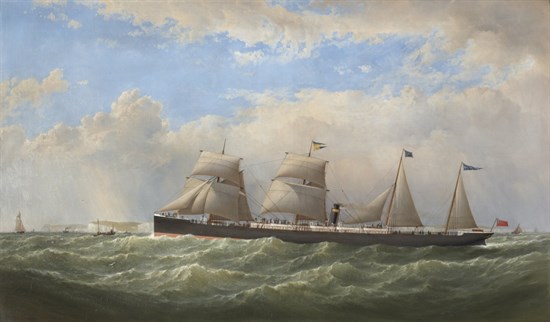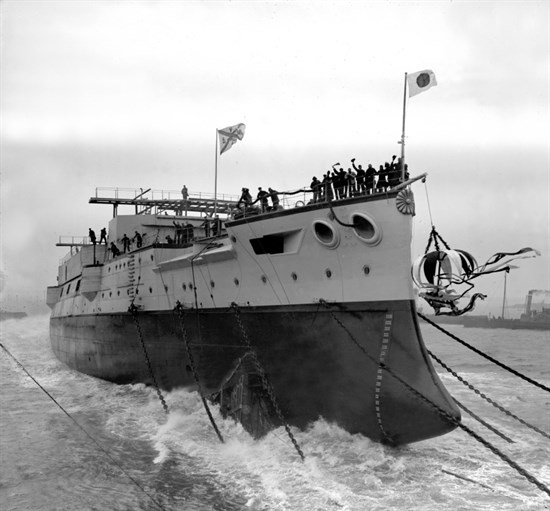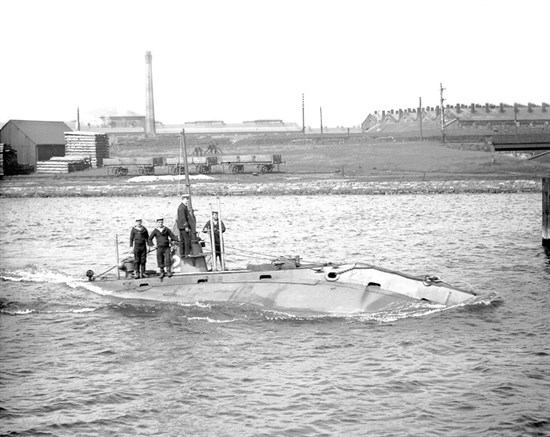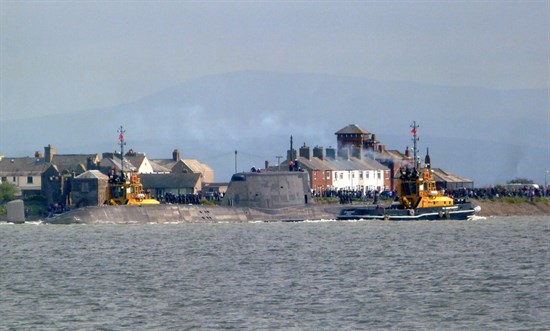Shipbuilding in Barrow
Setting up a new industry in Barrow
Towards the end of the 1860s, the iron and steel works in Barrow had become among the most productive in the world and their financial backers were looking for new markets for their output.
These business leaders had already financed the Furness Railway, and had started the building of a dock system at Barrow. It seemed a logical step to use these facilities to enable the setting up of a brand new industry for the town: iron and steel shipbuilding. After a meeting held amongst the financiers in January 1871, what was to become the Barrow Shipbuilding Company was created. On land that they had purchased on Barrow Island, experienced shipbuilders were brought to the town, mainly from Scotland, and then proceeded in constructing vessels of advanced designs.
The shipyard launched their first vessel, the steam yacht Aries in May 1873, and followed this in June with the passenger cargo ship, Duke of Devonshire, (named after the lead financier). Powered by a steam engine turning a screw propeller as well as sails, and weighing a then enormous 3,001 tons, it was designed to reach destinations in Asia served by the Eastern Steamship Company, another company owned by the backers of the Railway, iron and steel works, docks, and shipyard.


Gaining a reputation for innovation
The Barrow shipyard obtained a variety of orders during their first decade: passenger liners, dredgers, sailing ships, paddle steamers, and their first orders from the Royal Navy for gunboats. The speed at which the shipyard had become leaders in their field was illustrated when, in 1881, what was then the largest vessel in service in the world, City of Rome at 8,415 tons, was launched.
1886 saw the first submarine launched in Barrow, the first of two built for the Swedish industrialist Thorsten Nordenfelt. Although undertaking highly advanced projects, the Barrow shipyard was struggling financially and approached Nordenfelt with a view to him investing in the shipyard. He agreed, and in 1888 the shipyard was renamed the Naval Construction & Armaments Company. No longer just building ships and their machinery, but also using Nordenfelts’s expertise in gun design and production to diversify into armaments.
The order for HMS Vengeance in 1887 by the Royal Navy saw Barrow become the first shipyard in Britain able to build, engine, arm, and armour a battleship, something that was financially appealing to the Sheffield-based steel-making firm of Vickers Sons and Company. Forming a new company with the help of American-born inventor, Sir Hiram Maxim, the Barrow shipyard was bought later in 1887, and when HMS Vengeance was launched in 1899, Vickers Sons & Maxim Limited were the shipyard owners.
The new company sought to increase the productivity of the shipyard. Overseas orders were increased considerably, aided by the desire by many countries in the 1900s wishing to project their national pride by obtaining the latest in military hardware, something that the Barrow shipyard was willing and able to supply. Orders came in from Peru, Russia, Brazil, Mexico, China, Turkey, and Japan. The most celebrated Japanese battleship, Mikasa: flagship at the Battle of Tsushima in 1905 when Japan defeated Russia in a naval engagement, had been launched in Barrow in 1900. Mikasa is dry docked at Yokosuka, near Tokyo, and can be visited today.
Submarines, highs and lows
The Barrow shipyard was also chosen by the Royal Navy to build their first submarine: Holland 1 in 1901, and to develop the submarine into an effective fighting machine. Barrow was again chosen by the Royal Navy in 1908 to pioneer new military technology when they received the first order for a military aircraft in Britain: the design and construction of Airship No.1.
The First World War saw the shipyard workforce increase to over 30,000. Not only was the shipyard constructing the majority of submarines for Britain and a variety of surface vessels, but armaments production increased considerably. The production of airships also proceeded, aided by a young engineer and designer named Barnes Wallis.
After the war, orders fell, as did the workforce. Orders for liners did come from the Orient Line, but not enough to prevent a financial crisis that led in 1927 to the enforced amalgamation between the shipyard and its largest domestic rival, Armstrongs, based on the River Tyne in the north-east of England. Vickers Armstrongs Limited distributed orders for vessels and armaments between the two shipyards and a rise in orders occurred during the 1930s: for passenger liners and cargo vessels and also for British rearmament once it was perceived that another conflict was inevitable.
Again, the majority of British submarines that were used in the Second World War were built in Barrow, along with some renowned surface vessels such as HMS Ajax, and HMS Illustrious, and again the workforce grew. Inevitably, peace saw the orders and workforce shrink once again.


A brave new world
By the 1950s, the worldwide demand for oil increased and the shipyard engaged in the construction of oil tankers, and once again, passenger liners. These culminated in the largest passenger liner constructed in England: Oriana, launched in 1959, and the first tanker in Europe of over 100,000 tons, British Admiral, in 1965.
Britain’s first nuclear powered submarine, HMS Dreadnought was produced by the shipyard in 1960, and proved to critical in the Barrow shipyard's survival when the majority of British shipyards disappeared.
Orders for surface vessels were still forthcoming in the 1960s and 1970s including the aircraft carrier HMS Invincible, launched in 1977, but increasingly, the emphasis of shipyard production was on armaments, and nuclear-powered submarines.
The shipyard was nationalized in 1977, became part of British Shipbuilders and was renamed Vickers Shipbuilding and Engineering Limited. Privatised in 1986, the shipyard was taken over in 1995 and briefly was known as GEC Marine and Marconi Marine (VSEL) Limited, until 1999 when the shipyard became part of the new British-based defence company, BAE Systems.
The Astute and Dreadnought class nuclear submarines and their successors are continuing provide work for the shipyard and will do so for many years to come.
The Barrow shipyard from its inception in 1871 until the present day, has been at the forefront of engineering technology, has employed many thousands of workers in Barrow, and is still the largest employer in the town.
